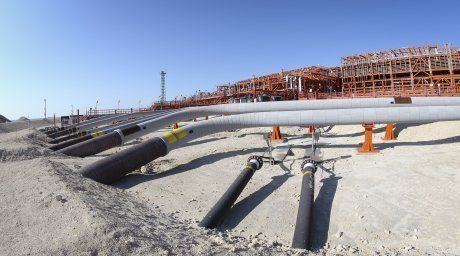 Kashagan oilfield. ©ReutersLosses from the forthcoming two-year suspension of the Kashagan oilfield development project in Kazakhstan are estimated at two billion dollars, tengrinews reports citing the findings of a senior Researcher at the Institute of Economics PWS Kazakhstan Oleg Yegorov.
Kashagan oilfield. ©ReutersLosses from the forthcoming two-year suspension of the Kashagan oilfield development project in Kazakhstan are estimated at two billion dollars, tengrinews reports citing the findings of a senior Researcher at the Institute of Economics PWS Kazakhstan Oleg Yegorov.
The operations at the oilfield have been halted for at least two years because the initially installed pipes failed to withstand corrosion boosted by toxic hydrogen sulfide. The pipes will have to be replaced, and the losses are expected to make billions.
Oleg Yegorov explained his calculations: "It was planned to produce three million tons of oil in 2014. At the price of $100 per barrel one ton is worth 700 dollars. In this case the year's total is worth $ 2.1 billion. Of these, 50% are taxes that go to the Kazakh state budget. So, we will come up $1.05 billion short. That is, in two years it will be about $ 2.1 billion short."
However, Yegorov said that setting Kashagan's downtime to as long as two years was an unnecessary foot-dragging. He believes that it is possible to restart the operation as soon as by the end of 2014, and that the losses to the Kazakhstan budget should speed up the Kazakhstani part of the decision-making. “The pipes procurement tender is likely to be held very quickly. Besides, all of it will be under quality supervision to make sure that the pipes are precisely the kind required to withstand the hostile environment of hydrogen sulfide," he said, adding that it was quite possible to replace the pipes in 7-8 months.
In some cases delays in projects emerge not from technical or technological complications, but from “some personal considerations of individual managers,” he added.
According to Yegorov, all the additional expenses arising from procurement of the materials, pipes in particular, will be incurred by the companies of the consortium, but not the state. However, he did not specify if KazMunaiGas, the state-run national oil and gas company that is a shareholder of the project, will also be exempt from the additional spendings, and if the consortium was in to compensate the Kazakh state budget for the lost taxes.
Yegorov’s 2-billion-dollar-loss scenario is a modest one in comparison to other analysts' estimations. For example, a more pessimistic forecast was provided by Kamilla Manakova, an Agency for Research ROI analyst. "Given the conditions on the Kashagan field, production resumption can be expected [only] around the spring - autumn of 2017," she said. In line with Manakova’s estimates, the losses of the NCOC consortium, which is responsible for development of the field, in two years will range between 5 to 28 billion dollars (but this us only if the planned daily production of 370,000 barrels of oil in the first phase will be achieved). Of these, the share of KMG Kashagan BV, the Kazakhstan government's arm in the consortium, will range from $850 million to five billion dollars.
Victor Neustoev, a leading analyst of Wild Bear Capital, also believes that losses from Kashagans' holdup will be considerably higher than those cited by Yegorov. He believes that even if compared with a very low production rate of 75 thousand barrels a day, the losses from the holdup will amount to 7.5 million dollars per day (or 5.475 billion dollars in two years). He also stressed that the delays in production would seriously hurt the oil companies, considering that 50 billion dollars had already been invested into Kashagan's development.
Oil giants like Eni, ExxonMobil, and Shell is involved in the project. Kashagan's appeal is that it is one of the largest oil discoveries of the past forty years. However, development of the oilfield has been haunted by delays, cost overruns, and adverse environmental implications since it started in 2001.
Kashagan is a gigantic offshore oilfield in Kazakhstan's section the Caspian Sea. Its holds recoverable reserves of about 13 billion barrels, but it is difficult to develop because of a very high content of hydrogen sulphide (a toxic gas harmful for both humans and equipment), pressure in the layers and shallow Caspian water that freezes up winter damaging the infrastructure.
Oil production at Kashagan eventually started on September 11, 2013. However, it was suspended 2 weeks later over a gas leak. The production was resumed shortly after, but only for another leak to be detected in October.
Now the Kashagan project is facing a shut down and the oil production will not be restarted until the operating company replaces all the pipelines. Some experts believe that Kashagan might end up closed until 2016 or even 2017.
The Kashagan oil field is developed by North Caspian Operating Company (NCOC). The shareholders are AgipCaspian Sea B.V. (16.81%), KMG Kashagan B.V. (16.81%), ConocoPhillips North Caspian Ltd. (8.4%), ExxonMobil Kazakhstan Inc. (16.81 %), Inpex NorthCaspian Sea Ltd. (7.56 %), Shell Kazakhstan Development B.V. (16.81%) and Total EP Kazakhstan (16.81%). ConocoPhillips has withdrawn from the Kashagan project selling its share to Kazakhstan's KMG. KazMunaiGas is expected to subsequently resell the share to Chinese CNPC.
For more information see:http://en.tengrinews.kz/markets/Counting-losses-from-Kashagan-suspension-252988/?
Use of the Tengrinews English materials must be accompanied by a hyperlink to en.Tengrinews.kz
 В Атырау
+28
В Атырау
+28  Send your news to AqZhaiyq
Send your news to AqZhaiyq